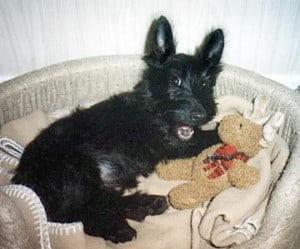From the Desk of Sharda Baker
Good day and welcome everyone!
This is Sharda again for another Scottish Terrier newsletter.
Today we will discuss about your Scottish Terrier and child safety!
Many children are very familiar with dogs, and may mistakenly assume that all dogs will be as gentle as family pets.
It is important to teach your children about dogs and to supervise your child’s activity with all dogs, including your own.
Most experts recommend that careful selection should be given to what breed of dog is most suitable for families with small children.
Highly aggressive breeds or breeds trained for hunting are not advised.
In addition, children must be taught not to tease or torment a dog, even though the children may see this as play. Most dogs will attempt to move away from an uncomfortable situation, but children may not realize why the dog is leaving..
Occasionally, there is a misconception by adults that a child and a puppy will learn together. It is simply not true. Often having a child responsible for caring for or training a puppy is unsafe for both the child and the dog.
Children can be excellent caregivers for family pets, but will require adult supervision to make sure that the situation is safe. Even the calmest family Scottie may bite or snap if cornered or overly excited.
Teaching children how to properly play with and care for dogs is critical to making the relationship positive and non-threatening for both the dog and the child.
Children will need to learn that dogs may interpret behaviours such as throwing a ball or picking up a toy as possible threats to them.
Children will need to be aware that all dogs are not safe. While the family pet may be docile and love to be petted and touched, strange dogs or strays may not like to be approached, and may react in aggressive ways.
Children should be taught to watch for the warning signs that a dog is becoming fearful or aggressive. Children should know to immediately leave a dog alone that growls, or attempts to run away when they approach.
Young children should not be left unsupervised with puppies or dogs. They may accidentally hurt the dog or puppy, and this may cause the animal to respond with aggression.
Children should also be taught that dogs do not reason the same way that humans do. Children may assume that the dog will understand the child’s intention is positive, and will become upset if the dog growls or tries to run away.
Food and feeding is another area of safety concern. A small child should not be responsible for feeding a dog, as there is a possibility of the dog knocking the child down to get at the food.
Even a small dog jumping up on a child can knock them off balance and cause a fall. This is unsafe for the child as well as a very bad habit for the dog to develop.
Feeding time is a high excitement time for most dogs, and if the dog is being fed with other dogs it can also be a very competitive time.
A small child is more likely to be seen as a threat to the dog if the child approaches a dog or puppy before it has been trained to understand that humans can interact with it while there is food present.
It is important to remember that dogs are creatures of instinct, and will act based on that instinct.
If care is taken to socialize, supervise and interact with your Scottie in a positive manner, the relationship between your family, your dog and other pets will be a long-lasting and rewarding experience.
I hope you learned a lot from today’s Scottish Terrier Newsletter.
All the best and take care
Warmly,
Sharda Baker

